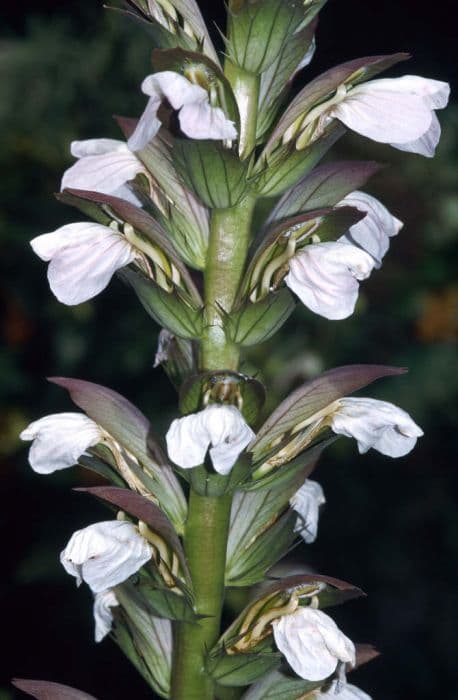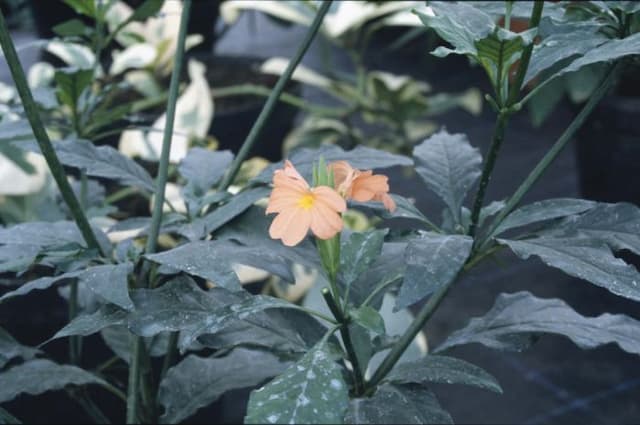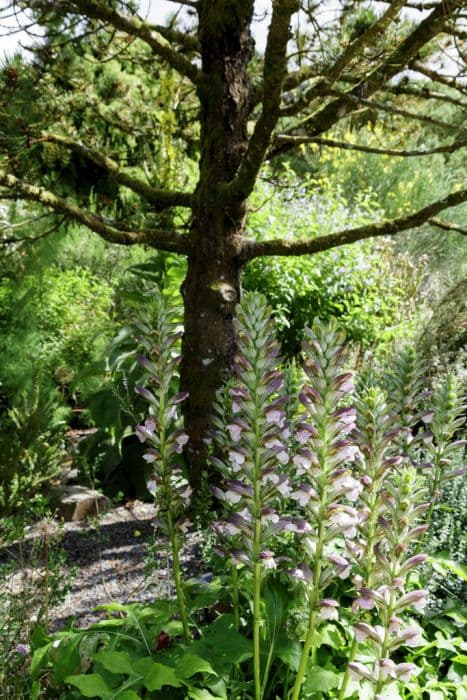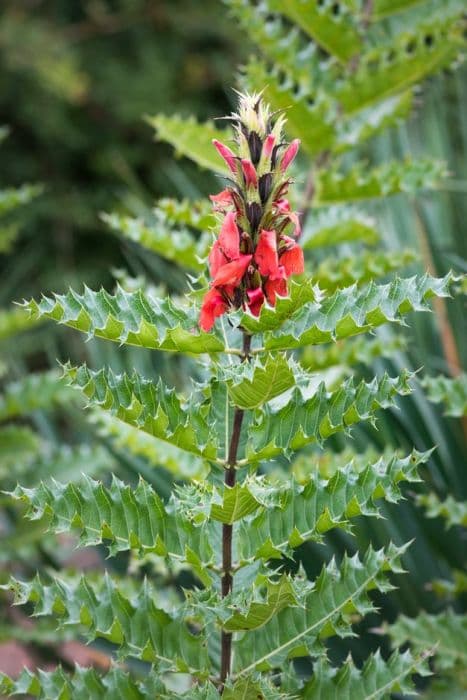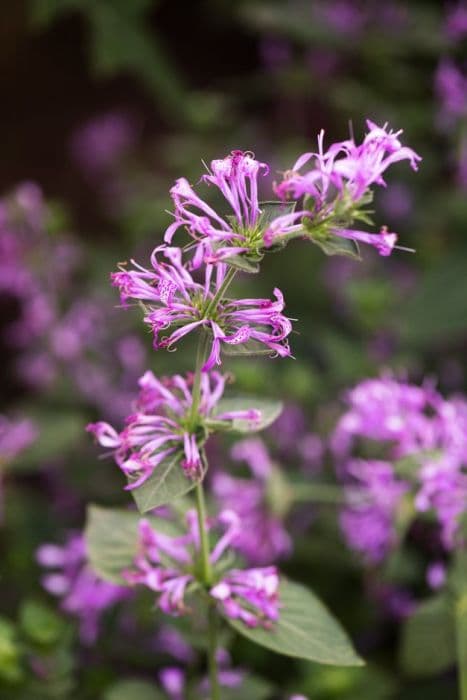Peristrophe speciosa Peristrophe speciosa

ABOUT
Peristrophe speciosa, commonly known as the Pink Peristrophe, is a visually striking plant that displays a vibrant array of color and form. This plant is characterized by its glossy, heart-shaped leaves that have a lush, velvety texture. The foliage typically shows off a rich green hue with contrasting veins that may appear to be slightly lighter in color, giving the leaves a somewhat variegated look. The Pink Peristrophe boasts beautiful flowers which are indeed the highlight of its appearance. These flowers are funnel-shaped and come in a brilliant shade of pink, sometimes with subtle striations of a darker or lighter tone that add depth and texture to the floral display. The blooms are arranged in clusters at the tips of the branches, creating a showy effect that can be quite eye-catching in a garden setting. Adding to its ornamental appeal, the stems of the plant are slender and may have a slight arch, giving the Pink Peristrophe a graceful silhouette. Depending on the specific conditions of its environment, the colors of both the foliage and the flowers can vary in intensity, sometimes becoming even more vivid. This plant can exude a tropical flair with its glossy leaves and vibrant flowers, fitting well in gardens that aim to create a lush, exotic atmosphere. While young, the Pink Peristrophe has a soft, almost herbaceous quality, but as it matures, it can become more robust, with its stems toughening up and its overall form filling out. Overall, the Pink Peristrophe is a decorative plant that can add a pop of color and a touch of the tropics to any suitable garden or container arrangement. Its vivid pink flowers and glossy green leaves make it a favorite among gardeners who desire to introduce a lively, colorful element to their plant collections.
About this plant
 Names
NamesFamily
Acanthaceae
Synonyms
Basket Plant, Greenhouse Peristrophe, Purple Wreath
Common names
Dicliptera speciosa, Peristrophe angustifolia, Peristrophe bivalvis, Peristrophe lanceolaria, Peristrophe paniculata, Peristrophe roxburghiana.
 Toxicity
ToxicityTo humans
The Peristrophe speciosa, commonly known as Pink Peristrophe, does not appear to have a well-documented profile for toxicity to humans in scientific literature. However, the lack of information does not necessarily mean the plant is safe to ingest. As with many plants, it is advisable to exercise caution and avoid consuming any parts of the Pink Peristrophe without proper knowledge of its effects. If any part of the plant is ingested and an adverse reaction occurs, it is important to seek medical attention promptly.
To pets
The Peristrophe speciosa, commonly referred to as Pink Peristrophe, is not well-known for its toxicity profile in pets. Comprehensive scientific data on its potential toxicity to pets like dogs, cats, and other domestic animals is limited. However, as with humans, the absence of information does not guarantee the plant's safety for pets. It is recommended to prevent pets from ingesting any part of the Pink Peristrophe, and if ingestion occurs and any symptoms of poisoning arise, immediate veterinary assistance should be sought. Symptoms could potentially include gastrointestinal upset, vomiting, diarrhea, or other signs of distress, though specific effects are not clearly established for this plant.
 Characteristics
CharacteristicsLife cycle
Perennials
Foliage type
Evergreen
Color of leaves
Varies
Flower color
Purple
Height
3 feet (0.91 meters)
Spread
2 feet (0.61 meters)
Plant type
Shrub
Hardiness zones
10
Native area
Asia
Benefits
 General Benefits
General Benefits- Ornamental use: Peristrophe speciosa, commonly known as the magenta plant, is often grown for its vibrant and attractive foliage that adds aesthetic appeal to gardens, borders, and as a specimen plant in landscaping.
- Pollinator attraction: The magenta plant can attract various pollinators to the garden, such as bees and butterflies, helping to promote pollination in the surrounding flora.
- Shade tolerance: This species is capable of growing in partially shaded conditions, making it a suitable choice for garden areas that do not receive full sunlight.
- Drought resistance: Once established, the magenta plant has a degree of drought resistance, which makes it suitable for xeriscaping or gardens that receive limited water.
- Ease of propagation: It can be easily propagated from stem cuttings, allowing gardeners to create new plants without the need for seeds.
- Fast growth: The magenta plant is known for its relatively fast growth rate, which allows it to quickly fill in garden spaces or pots.
 Medical Properties
Medical Properties-
- Anti-inflammatory: Peristrophe speciosa may have compounds that help reduce inflammation.
-- Antibacterial: Extracts from the plant have shown antibacterial activity against certain strains of bacteria.
-- Wound healing: It is traditionally used to promote wound healing due to its possible antibacterial and anti-inflammatory effects.
-- Antioxidant: The plant may contain antioxidants that help protect the body from oxidative stress.
-- Antipyretic: There is traditional usage as an antipyretic to reduce fever.
-- Gastroprotective: Peristrophe speciosa might possess gastroprotective properties, helping in maintaining stomach health.
 Air-purifying Qualities
Air-purifying QualitiesThis plant is not specifically known for air purifying qualities.
 Other Uses
Other Uses- Peristrophe speciosa, commonly known as Purple False Eranthemum, can be used as a natural dye for fabrics due to the pigments found in the leaves and stems.
- The Purple False Eranthemum's vibrant leaves can be used for decorative purposes in floral arrangements or as a natural festive confetti.
- In some cultures, the plant is believed to bring good luck and is thus kept in homes and gardens to attract positive energy.
- The fibrous stems of the Purple False Eranthemum might be used in the production of handmade paper or as a fibrous additive for craft projects.
- Its bright foliage is used in landscaping as ground cover to create a visually striking border or to fill in shaded areas of a garden.
- Artists and crafters could use the crushed leaves to make natural paint or ink for eco-friendly art projects.
- As a fast-growing plant, Purple False Eranthemum can be used in education settings for botanical studies and biology experiments regarding growth and photosynthesis.
- The plant can serve as a food source for certain species of butterfly and moth larvae, playing a role in butterfly gardening.
- Its ability to grow in partially shaded areas can be utilized to provide under-canopy growth in agroforestry systems, contributing to soil health and moisture retention.
- When dried, the leaves and stems of the Purple False Eranthemum have potential use as a natural filler for pet bedding due to their softness and potential aromatic properties.
Interesting Facts
 Feng Shui
Feng ShuiThe Peristrophe speciosa, commonly known as Market Plant, is not used in Feng Shui practice.
 Zodiac Sign Compitability
Zodiac Sign CompitabilityThe Market Plant is not used in astrology practice.
 Plant Symbolism
Plant Symbolism- Vitality: Due to its vibrant colors, Peristrophe speciosa, commonly known as Pink Peristrophe, often symbolizes life and energy, reflecting its lush and vigorous growth.
- Healing: In some cultures, Pink Peristrophe may represent healing, as it has been used in traditional medicine to treat various ailments.
- Transformation: Because this plant can change color when the pH balance in the soil differs, it's sometimes associated with change and adaptability.
- Beauty: The Pink Peristrophe's aesthetic appeal may symbolize beauty and grace in a garden setting.
- Harmony: Cultivated for its pleasing appearance, the Pink Peristrophe might represent balance and harmony in nature.
 Water
WaterThe Peristrophe speciosa, commonly known as Bicolor Persian Shield, requires consistent moisture and should be watered when the top inch of soil feels dry to the touch. Generally, watering once a week with about 16 to 32 ounces of water should be sufficient, but this may vary depending on environmental conditions such as temperature and humidity. During hotter months, it may need more frequent watering. It’s important to avoid overwatering, which can lead to root rot. Ensure the plant pot has proper drainage to prevent excess water from sitting at the bottom.
 Light
LightBicolor Persian Shield thrives in bright, indirect light. A spot near an east or south-facing window where it can receive plenty of light without being exposed to harsh direct sunlight for extended periods is ideal. If the light is too intense, it can scorch the leaves, while insufficient light can cause the plant to become leggy as it stretches towards the light source.
 Temperature
TemperatureBicolor Persian Shield prefers warm conditions and should be kept in a range where temperatures are between 60 and 85 degrees Fahrenheit. It can survive minimum temperatures down to about 50 degrees Fahrenheit, but growth will be significantly reduced. Protect the plant from cold drafts and sudden temperature changes to maintain its health and vibrant foliage.
 Pruning
PruningPruning Bicolor Persian Shield helps maintain its shape and encourages bushier growth. Trim the plant in early spring or after flowering to remove any leggy stems and spent flowers. Pruning can be done every few months to keep the plant looking tidy. The best time for major pruning is before the growing season begins.
 Cleaning
CleaningAs needed
 Soil
SoilThe best soil mix for the Queen's Wreath should be rich, well-draining, and loamy with a pH of around 6.5 to 7.5. Incorporate peat, compost, and perlite to enhance fertility and improve drainage.
 Repotting
RepottingQueen's Wreath should be repotted every 2-3 years or when it becomes root-bound. Repotting is best done in spring or early summer when the plant is actively growing.
 Humidity & Misting
Humidity & MistingQueen's Wreath thrives in high humidity levels, ideally between 60-70%. Maintaining these conditions will promote lush foliage and healthy growth.
 Suitable locations
Suitable locationsIndoor
Place Queen's Wreath in bright, indirect light indoors; ensure high humidity.
Outdoor
Plant in partial shade, protect from strong winds, and water regularly.
Hardiness zone
10-11 USDA
 Life cycle
Life cyclePeristrophe speciosa, more commonly known as Pink Peristrophe, begins its life as a seed that, when conditions are suitable, germinates in soil. Upon germination, it rapidly grows a root system and sends up shoots that will develop into distinctive, green leaves. As it enters the vegetative state, the plant continues to grow both roots and leaves, forming a bushy structure, and once mature enough, it starts to produce flowers. These flowers are usually bright pink or purple, attracting pollinators required for the next stage of reproduction. Following pollination, seed formation occurs within the flowers, which, once mature, are dispersed by various means, including wind or animal assistance. Finally, when the seeds find an appropriate place to settle, they begin the cycle anew, ensuring the continuation of the species.
 Propogation
PropogationPropogation time
Spring to Summer
Propogation: Peristrophe speciosa, commonly known as Pink Peristrophe, is often propagated through stem cuttings. This propagation method is popular because it is relatively simple and produces clones of the parent plant, ensuring consistency of plant traits. To propagate Pink Peristrophe from stem cuttings, a healthy, disease-free stem of about 4 to 6 inches (approximately 10 to 15 centimeters) is cut from the parent plant using a sharp, sterilized pair of scissors or pruning shears. The lower leaves are removed, and the cut end is dipped in rooting hormone to encourage root growth. The cutting is then inserted into a pot filled with moist, well-draining soil or a mix of peat and perlite. It should be placed in a warm environment with indirect sunlight and kept consistently moist but not waterlogged. After a few weeks, roots will develop, and the new Pink Peristrophe plant can be transferred to a larger pot or planted outside if climate conditions are suitable.



